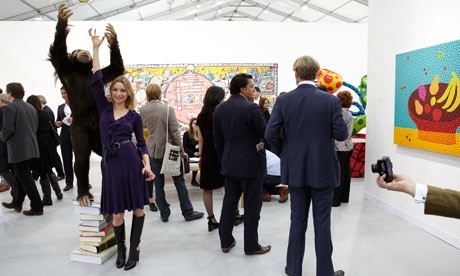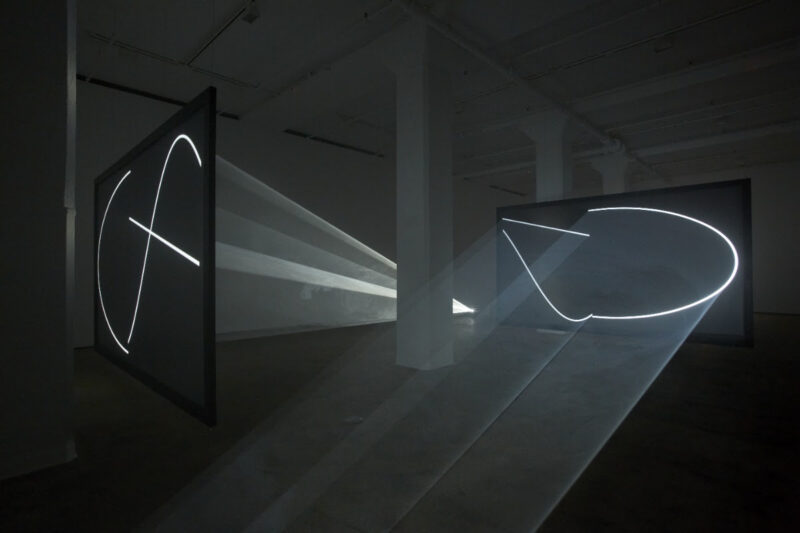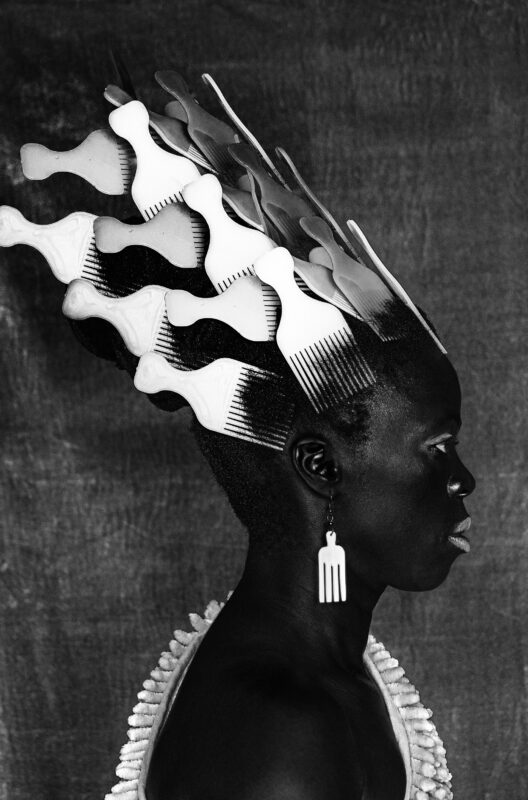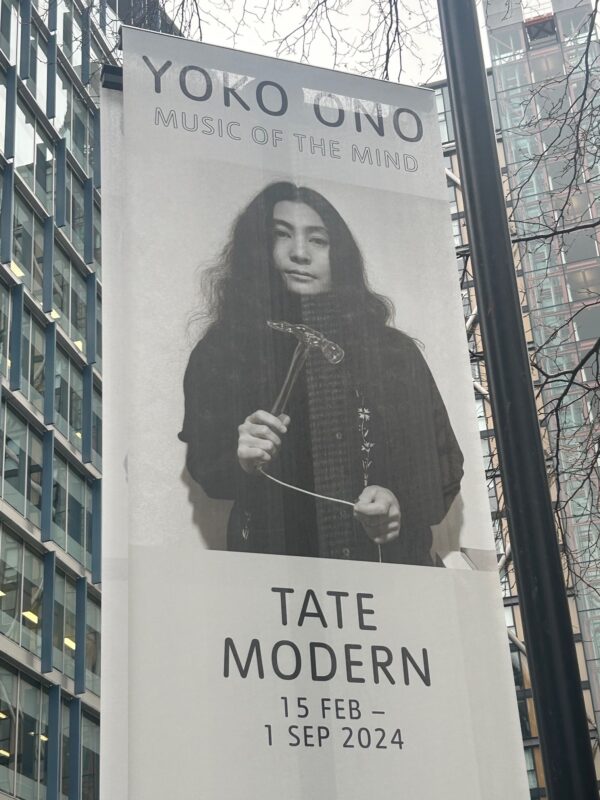
Punters, artists and art dealers at the Frieze art fair in London last Tuesday. Photograph: Andy Hall for the Observer
Frieze 2011 art fair has become a monster. A giddy, hilarious, silly-shoed one that looks slightly like a hedge-fund manager and slightly like a madcap genius and quite a lot like FUN. But still: a monster. After just eight years of existence, we now talk of “Frieze week”: the seven days when, to coincide with Frieze’s opening, London’s galleries unleash their big guns.
The list of shows is staggering: Gerhard Richter at Tate Modern, with Tacita Dean in the Turbine Hall, Doug Aitken at Victoria Miro, Rebecca Warren at Mauren Paley, everyone and everything at the new White Cube. Tracey Emin, Jeremy Deller, Sarah Lucas, Ryan Gander, among others, have one-off works on show across London. And that’s before you get to the big, white tents of Frieze in Regent’s Park, packed with art art ART from all over the world.
Fine by me: I like being overstimulated and having too much to do. Plus, Frieze is amazing for people-watching: scruffy-bearded artists mingling with pink-chinoed money men, all sozzled and chatty. There are a lot of impressive women around: they stalk through the week, hard-boiled in Botox and Pantene. No matter what their age, their legs are slim and lovely.
On Tuesday, the day before Frieze opens, my art friend Louise sends me a list of parties and private views. We plan to hit the opening of White Cube Bermondsey, the Lisson Gallery party and finish off at the poolside shindig for Doug Aitken at Shoreditch House. But then Louise cries off with a cold, so I go to what I want instead. Which is: Charles Avery at Pilar Corrias and the Museum of Everything party. At the Charles Avery show – which builds on his Islanders project, with work including a utopian yet scary depiction of a shopping precinct – I bump into my artist friend Keith Wilson, plus Ian Dench, ex-EMF (who was an art student for one year, pop fact fans). We go to the pub for a bit with their mates. “Don’t peak too early,” I am advised. “It’s like a massive wedding. There are parties all week.”
Yes, but some of us have only one night out. So off to the Museum of Everything party I trot. Held in a derelict hotel behind Selfridges, also the site for the Judith Scott retrospective (runs until 25 Oct), this turns out to be a proper, old-school, warehouse knees-up: big queues for the portable lavatories, free booze and plenty of it. A brass band plays bonkers mariachi. People wear stupid hats. It’s great.
The partygoers mingle between Scott’s colourful wrapped pieces, which hang in groups from the ceiling. Judith Scott, who died in 2005 aged 61, was born deaf and with Down’s syndrome. She was institutionalised until her 40s, when she started making art. I really recommend this exhibition: not just for the artwork, which is impressive, but also for the environment – it’s so exciting to be in a big, rough space slap in the middle of London.
M of E also has a group show, displaying pieces made by artists with learning disabilities, held in a series of ram-a-jam rooms at the bottom of Selfridges (to 25 Oct). I found it very moving; there is some beautiful work. You’re left with interesting questions, too: can a creation actually be art if its creator doesn’t – or can’t – classify it that way?
At Frieze proper, on Wednesday afternoon, we queue between barriers like we’re at the log flume at Disneyland. Once in, the fair is bewilderingly big. I sit down to consult my map and see Matthew Slotover, Frieze’s co-founder. He tells me that “you need to do your research before you come”. All the artworks at Frieze are online and you can search for, say, “European photographers under 35”. I’ve done no research at all. Still, I wander about and manage to clock the Chapman brothers’ warped Virgin and child piece, Michael Landy’s Heath Robinson machine, which chews up credit cards, and Pierre Huyghe’s aquarium, one of Frieze’s commissions. A hermit crab bobbles about, wearing a shell that looks like a Brancusi head, clacking its pincers, happy in its new home. The aquarium is in a darkened room, lovely and restful.
Slotover tells me that this year, although buyers are cautious, there isn’t the panicky feeling that there was during Frieze 2008. Then, the fair came straight off the back of the collapse of Lehman Brothers “and no one was buying anything, not art, not property, nothing for about three months”. He says that worries about the euro are holding some back – the majority of buyers at Frieze come from Europe and the US – but that Latin Americans are investing. “They buy more contemporary stuff, by living artists under 50. And they live with the work, rather than put it into storage. It’s not a trophy or an investment.” Unlike the Russians, apparently, who are still in search of blue-chip, high-end, modern works.
I wonder if anyone will buy Christian Jankowski’s piece, which is all about art and money. He has bought a beautiful motorboat, made by a specialist boat builder, and is offering it for €500,000. Or €625,000 if Jankowski adds his name, in shiny letters, to it. The letters are scattered on the carpet, waiting. You can also commission a 65-metre super-yacht, via him, at €65m; €75m with his name plaque.
Jankowski is a cheerful bloke. We have a chat: he says he’s trying to stop rich buyers just investing in a Picasso and then displaying it “with matching cushions in the colours of the Picasso”. He wants to encourage them to be more imaginative. “Maybe they want a boat. With this, if they use the boat, and it’s not an artwork, its value goes down. But if it’s art, its value should go up.” I can’t believe that anyone will buy it, but he says he’s had interest from one lady, who is bringing her husband to see him on Saturday.
Frame is my favourite section of Frieze. Established in 2008, it showcases smaller galleries, which are allowed to exhibit just one artist in their allotted space. The floor is uncarpeted, there’s a rougher feel. Mostly, the work is made by younger people, though I was happy to see that Channa Horwitz, who’s almost 80, is displaying her playful sequences at Aanant & Zoo. At Hunt Kastner, a gallery from Prague, I liked Eva Kot’átková’s work: her collages of old books and photographs, as well as a slideshow, cluster and fold together. Apparently, she’s exploring identity disorder, where troubled individuals create parallel personas to cope with their roles in society. We can all relate.
Outside Frame, in the main corridors, which increasingly resemble an out-of-town mall, or an insane asylum, I pop into Gavin Brown’s enterprise, winner of the Stand prize. Bright canvases by Joe Bradley and poppy pieces by Martin Creed encircle an enormous golden, folded coat hanger by Mark Handforth. I dislike that one.
Still, at Frieze, as soon as you’ve seen something you hate, you fall over something you like. Casey Kaplan, a New York gallery, has given over its whole space to Matthew Brannon. There are handpainted posters, little railway station signs, a collection of coloured bottles. On the wall hang two coats: the detective’s and the dentist’s. Naughty ladies peek out from the coat pockets; a ribbon with “my fingers in your mouth” hangs from a collar. Brannon has written a murder mystery that takes place in several countries (there’s an accompanying exhibition opening in New York) and his work offers clues to the story. The whole thing is entrancing: funny, detailed, confusing. I have found a new artist to follow.
Frieze is an overlit, overpeopled, overheated carnival of excess that has given me a couple of new images to mull over. I hold them close, to calm me down, and leave before my migraine kicks in.
guardian.co.uk © Guardian News & Media Limited 2010
Published via the Guardian News Feed plugin for WordPress.
Categories
Tags
- channa horwitz
- chapman brothers
- Charles Avery
- Christian Jankowski
- Critics
- culture
- Doug Aitken
- Exhibitions
- Frieze
- Frieze art fair
- Frieze Art Fair 2011
- Frieze London
- Jeremy Deller
- JOE BRADLEY
- Martin Creed
- Matthew Slotover
- Michael Landy
- Miranda Sawyer
- Rebecca Warren
- Reviews
- Ryan Gander
- Sarah Lucas
- Tate Modern
- The New Review
- The Observer
- Tracey Emin
- Turbine Hall









